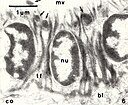File:American malacological bulletin (1988) (18157487991).jpg

Original file (2,146 × 1,755 pixels, file size: 1.38 MB, MIME type: image/jpeg)
| This is a file from the Wikimedia Commons. Information from its description page there is shown below. Commons is a freely licensed media file repository. You can help. |
Summary

|
The categories of this image need checking. You can do so here.
|
| DescriptionAmerican malacological bulletin (1988) (18157487991).jpg |
English: Title: American malacological bulletin |
|||
| Date | ||||
| Source |
https://www.flickr.com/photos/internetarchivebookimages/18157487991/
|
|||
| Author | Internet Archive Book Images | |||
| Permission (Reusing this file) |
At the time of upload, the image license was automatically confirmed using the Flickr API. For more information see Flickr API detail. | |||
| Other versions |
|
|||
| Volume InfoField | 1988 | |||
| Flickr tags InfoField |
|
|||
| Flickr posted date InfoField | 27 May 2015 |
Licensing
| Public domainPublic domainfalsefalse |
This work is in the public domain because it was published in the United States between 1978 and March 1, 1989 without a copyright notice, and its copyright was not subsequently registered with the U.S. Copyright Office within 5 years.
Unless its author has been dead for several years, it is copyrighted in the countries or areas that do not apply the rule of the shorter term for US works, such as Canada (70 pma), Mainland China (50 pma, not Hong Kong or Macau), Germany (70 pma), Mexico (100 pma), Switzerland (70 pma), and other countries with individual treaties. See this page for further explanation. Deutsch ∙ English ∙ español ∙ français ∙ italiano ∙ 日本語 ∙ 한국어 ∙ македонски ∙ português ∙ português do Brasil ∙ русский ∙ sicilianu ∙ slovenščina ∙ 中文(简体) ∙ 中文(繁體) ∙ +/− |
| This image was originally posted to Flickr by Internet Archive Book Images at https://flickr.com/photos/126377022@N07/18157487991. It was reviewed on 17 September 2015 by FlickreviewR and was confirmed to be licensed under the terms of the No known copyright restrictions. |
17 September 2015
Captions
Items portrayed in this file
depicts
some value
1988
image/jpeg
3929b98fd1a45556d24bdcb19c20c461f663739d
1,448,511 byte
1,755 pixel
2,146 pixel
File history
Click on a date/time to view the file as it appeared at that time.
| Date/Time | Thumbnail | Dimensions | User | Comment | |
|---|---|---|---|---|---|
| current | 13:40, 17 September 2015 |  | 2,146 × 1,755 (1.38 MB) | Fæ | == {{int:filedesc}} == {{subst:chc}} {{information |description={{en|1=<br> '''Title''': American malacological bulletin<br> '''Identifier''': americanmal6719881990amer ([http://commons.wikimedia.org/w/index.php?title=Special%3ASearch&profile=default&... |


